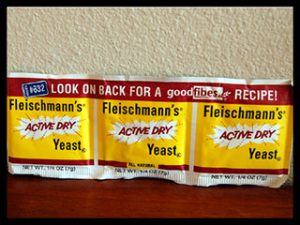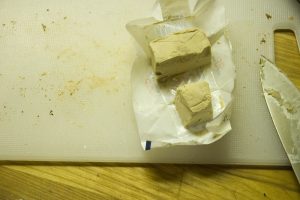Yeast
Vicki Mendham
Yeast is a Leavening Agent in yeast bread production that’s main purpose is flavor and leavening.
Yeast is a microscopic plant that ferments by acting on sugar and changing that into Co2 and alcohol. ( the alcohol evaporates)
- Acts on sugars
- Contributes to flavor
- Compressed/Fresh preferred by professional Bakers, but more restaurant kitchens are using active dry yeast.
- Mix yeast in 100 degree water
Yeast: Compressed Vs. Fresh and Active Dry
Fresh yeast (also known as Compressed) is moist and very perishable. Pay close attention to use by dates and keep in refrigerator. It also may be frozen, but it is recommended to test that it is alive before using.
You can check the yeast by adding a 1/2 Cup of warm water to the yeast for the recipe and about 1 teaspoon of the sugar. After about 10 minutes you will see significant bubbles and you will know the yeast is alive.
Active Dry Yeast is granules of dried yeast that must be rehydrated in water from the recipe. Typically use water around 100 degrees as to not kill the yeast.
Rapid Rise Yeast or Instant Yeast is dried yeast that sometimes does not need to be dissolved ahead of time because it has a special coating and absorbs water more quickly. Many bakers still dissolve the yeast in advance to assure it is all dissolved. Less instant dry yeast may be used than active dry.
Osmotolerant Yeast is used in many sweet dough formulas. You may use osmotolerant yeast because of the high sugar quantity in a recipe. It is a instant yeast that performs better with high sugar quantity.

Dissolve yeast in water for most recipes:
Dry: Use 4x’s weight of the water from the recipe to dissolve the yeast in
Compressed: Use 2x’s weight of the water from the recipe to dissolve the yeast in
To Convert to use active dry:
If a recipe calls for compressed and all you have is compressed/fresh yeast, use only 50% of specified compressed amount.
Ex. 1 pound compressed = 8 ounces dry
multiply the specified compressed amount by .5 to determine the amount (use half)
If you only have compressed/fresh yeast and it calls for active dry, you will need to double the amount.
One packet of yeast equals about 2 1/4-3 teaspoons of yeast.
Yeast temperatures to note; yeast is temperature sensitive. Be aware of the following temperatures when adding water to yeast as well as putting yeast dough in proof boxes.
- 34 Degrees= Yeast is Inactive
- 60-70 Degrees= Yeast has slow action
- 70-90 Degrees= Best growth temperature for yeast
- Above 100 Degrees= Reaction of the yeast slows down as it is too hot
- 140 Degrees= Yeast is killed; typically this happens in the oven
Decrease Proof Time
You can increase yeast amounts within narrow limits to decrease rise time. If you increase by too much, the finished product will not have the correct crumb and will taste too yeasty. Only do this for emergencies.
To decrease time, divide the old time in minutes, by your preferred time in minutes to come up with a factor to multiply the yeast by.
Old Time/New Time = Factor To Multiply Yeast by
90 minutes/60 minutes=1.5 Yeast amount x1.5=New Yeast Amount


